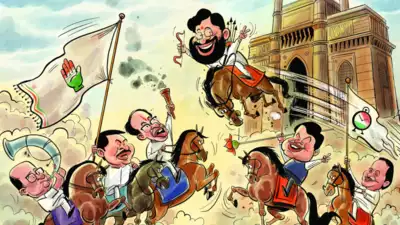Maharashtra election results: Explained: What drove Mahayuti's ...
Get Hindus together: BJP took lessons from LS losses, some of which were attributable to Muslim consolidation. Example: Dhule's Lok Sabha seat, which BJP lost by 4,000 votes. Its candidate led in all assembly segments except in Muslim-dominated Malegaon where it trailed by 1,94,000. In assembly polls, BJP worked closely with RSS and its affiliates, as well as in collaboration with Hindutva civil society. Muslim clerics' demands, including 10% quota and preference for the community in police recruitment, helped counter-mobilisation of Hindus.Get Dalits back: LS results showed BJP had lost some Dalit support, in part because of 'quota under threat' campaign by Congress. For state polls, BJP went out of its way to tell Dalits they were 'misled'. Minorities affairs minister Kiren Rijiju, a Buddhist, was tasked with reaching out to neo-Buddhists, a substantial part of Dalits. SC's order approving sub-categorization of SC quota sharpened contradictions among SCs, and Dalit vote splintered. In Marathwada, the MMM (Muslims, Marathas, Mahars) factor that went against BJP was blunted this time.Calming down Marathas: Jarange Patil, self-appointed champion of Marathas, lost credibility, which helped BJP. Maratha voters noted that the only Maratha with a good chance of becoming CM was Mahayuti's Eknath Shinde. Plus, a goodish number of Maratha heavyweights from Western Maharashtra were contesting as Ajit Pawar NCP candidates, and BJP also has resourceful Marathas in its ranks.ABC of OBC consolidation: This was another gift Jarange gave BJP. His aggressive rhetoric for Marathas, combined with his targeting of BJP, drove OBCs to Mahayuti, who saw MVA as an enabler of Jarange. OBCs made a difference in seats in all regions of the state, complementing the fracturing of the Maratha vote.

Welfare plus: Shinde's Ladki Bahin scheme, Rs 1,500/month for poor women, and sops for young voters, farmers and others helped Mahayuti. But strengthening that factor was the voter perception that MVA, during its stint in office, scrapped more projects than it started, while Mahayuti was seen as a project launcher. In India's richest state with many urban centres, this was a major election advantage.Agri wasn't disagreeable:
Poor farm incomes hurt Mahayuti in LS polls. GOI had lifted the ban on onion exports too late to make a difference. The difference was felt by the time assembly polls came round, by which time, soybean and dairy products also fetched better prices. Combined with cash payments for poor women, most of them rural, got the major chunk of village vote back to Mahayuti.Better friends: Mahayuti allies combined better. It is not that there were no differences, but they paled before the constant bickering among MVA partners. The prime time routine of UBT Sena's Sanjay Raut and Congress's Nana Patole having a go at each other were rank bad optics. Intra-alliance fights delayed seat-sharing in MVA and raised doubts about its viability. That there were suspicions that Sharad Pawar may pull out new rabbits out of his hat post-poll didn't help either.Sympathy plus 'secularism' was bad maths: Uddhav's bet on voters' support for his having been 'wronged' by Shinde was always a tricky strategy - elections are hard-nosed affairs. But UBT Sena doubled down on it, making it the central plank of its poll campaign. And in an election where
Hindu consolidation
was clearly in progress and RSS had fanned out to help BJP's Hindutva messaging, Uddhav's virtual abandonment of Balasaheb's hard Hindutva became a liability. That he dropped his support for the Waqf bill after protests by Muslim groups was a gift to BJP and Shinde Sena.

















































